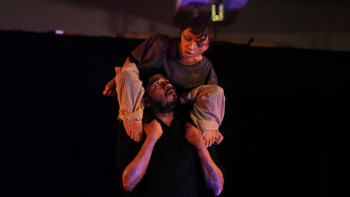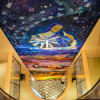‘Matir Manush’: Rasel Rana brings Bengal’s iconic tepa dolls to canvas

One of my earliest memories in Kushtia is of the colourful, locally-made clay dolls from the Rath Yatra fair, the annual Hindu chariot festival held in July. As a child, I was fascinated by these charming figurines. In fact, my mother grew up in a household where buying these dolls from the fair was synonymous with buying happiness—not just for her family, but also for the artisans who made them. The dolls varied in size, but one kind stood out due to its unique shape and intricate details— the tepa putul (clay dolls). Though they are traditionally associated with the Rath Yatra, these dolls are crafted and sold year-round, remaining a beloved toy for children across Bengal.


'Tepa' refers to the act of molding clay with one's fingers, while 'putul' means dolls. According to researchers, the history of these dolls traces back to the terracotta sculptures of the Indus Valley Civilisation, with clear similarities in form. As such, the tepa putul carries with it the cultural heritage of the entire Indian subcontinent. However, with changing times and a dwindling population of artisans, this art form is on the brink of extinction.

"Matir Manush," Rasel Rana's first solo exhibition, is a heartfelt call to preserve and appreciate the art of tepa putul. Organised by Shilpangan and Bhumi, the exhibition was inaugurated on October 12 at Bhumi Gallery, with prominent architect and artist Mustapha Khalid Palash in attendance as the special guest. Artist Professor Rashid Amin praised Rana's work, while the chief guest, renowned artist Mohammad Yunus, officially opened the exhibition.

Rasel Rana, an emerging artist and graduate of the Department of Graphic Design at the University of Dhaka, has immersed himself in the art of tepa putul painting. The delicate yet precise craftsmanship of potters, who shape these dolls from clay, finds new life in Rana's two-dimensional canvases. Though tepa putul is a rural tradition, it has long reflected the spirit of the Bengali people, as evidenced by its inclusion in the works of Shilpacharya Zainul Abedin. Following in his footsteps, Rana captures the beauty and significance of this art form in his own work.


The exhibition title, "Matir Manush" (which means "people of the soil"), is a term used to describe humble, down-to-earth individuals. Fittingly, the tepa dolls often depict our people, birds, and animals. Inspired by this concept, Rana has created captivating paintings that portray the simple lives of rural Bengal. His works depict women draped in sharees, engaged in everyday activities—working, conversing, tending to children, or fetching water by the river—accompanied by birds, flowers, traditional hand fans, and more. In one notable piece, tepa children are shown watching Shilpacharya Zainul Abedin as he paints.


Rana's art also features elements of Nakshi Kantha (a traditional Bengali craft) and the Liberation War of 1971. Scenes of floods, thatched-roof houses, clay water pots, banana trees, and mud houses appear throughout his work. The expressive facial features of the figures add a unique charm to his 38 paintings, which use acrylic and mixed media. Among these, my personal favorites are a bride with an owl and the ornamental rendering of the word 'Maa.'


"Matir Manush" offers a glimpse into the past, connecting viewers to their childhood and introducing a vital cultural tradition to the younger generation. The brushstrokes, colour palettes, shading, and facial expressions all speak of Rana's artistic mastery.
The exhibition is open to all and will run at Bhumi Gallery until October 22.

 For all latest news, follow The Daily Star's Google News channel.
For all latest news, follow The Daily Star's Google News channel. 









Comments